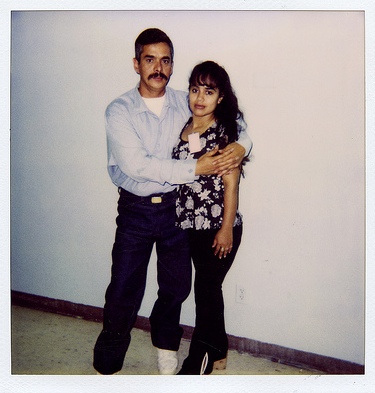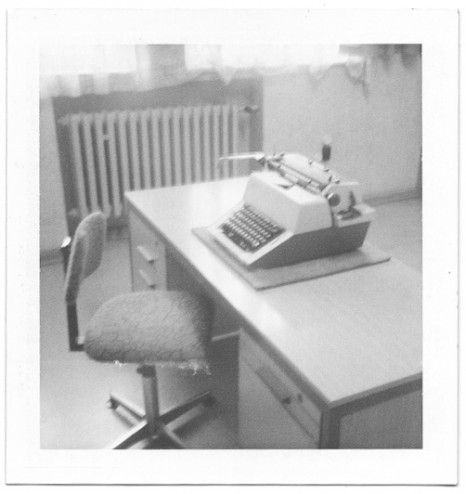You are currently browsing the tag archive for the ‘Polaroid’ tag.

I wrote recently about Davi Russo‘s family portraits made inside two New Jersey State prisons between 1987 and 2007: 20 years of prison polaroids chart son’s resolve, love, and only contact with dad.
The Polaroids chart visits he, his mother, sister, grandparents and friends made to see his father David who was incarcerated on suspicion of murder in 1984, stood trial, and was found guilty and sentenced, in 1987, to life plus 20 years. He has been eligible for parole since 2010 but remains in prison today. Russo, a director and photographer these days, was nine years old at the time of his father’s conviction.
Russo hoped sharing his experience might help others get free of the stigma of incarceration too.
“Growing up with Shawshank Redemption and all the horrible prison TV shows, I wanted to take authorship,” explains Russo. “I had a chance to put something different together. And it was legitimate. Polaroids are thought of as the most fun type of photography. Super quick, on the beach, snap, shake it. The world is perfect! Shoot it on polaroid! But not for me. I didn’t experience polaroids that way and I knew I wasn’t the only one.”
Russo was reluctant to share the photos publicly for many years and when he finally did he asked his father to write a reflection on the collection. Instead, his father wrote single memories on Post-It notes of each photo … of each moment they stood before the camera. Those written memories became the captions for each image–an unexpected and personal twenty year narrative. Therefore, I encourage you to visit the series, which Russo has named Picture Time, on Russo’s website and read the full captions. There too, you will find essays by Russo’s sister and mother.
–
Read and see more: 20 years of prison polaroids chart son’s resolve, love, and only contact with dad.








In the past when I have discussed prison Polaroids, I have said they are perhaps one of the more significant subsets of American vernacular photography, and that they are not easily found online and that, due to their absence, our perception of prisons and prison life continues to be skewed.
Well, times change and that position now deserves correction. I have noticed a few collections coming online recently. Not least the Polaroids from Susanville Prison on the These Americans website. (Also, check out the new PRISON subsection of the site.)
Online, I have identified some increase in the number of contemporary prison visiting room portraits and, as in the case of These Americans, collections of older, scanned images.
I would suppose that many Facebook users have scanned visiting room portraits and added them to profiles but, only visible to friends, those social network image files have not been reproduced for public consumption or commentary. We might think of Facebook photos and albums as digital versions of the mantlepiece, i.e. seen only by close friends and family.
ONGOING FOCUS
“Prisoner-complicit” portraits (for want of a better term) are taking up a lot of my thoughts currently.
Yesterday, I had a workshop with the #PICBOD students at Coventry University, in which I assigned readings on Alyse Emdur’s visiting room portrait collection, prison cell phones as contraband, prison cell phone imagery as cultural product, a new Tumblr In Duplo that compares publicly available mugshots with publicly available Facebook profile pictures, and the racket that underpins the posting and removal of mugshots to the searchable web.
Particularly with cell-block-cell-phone images, we should anticipate a glut of prisoner-complicit photos in which prisoners – to a greater degree – self represent.
We should realise that this is the first time in modern history that prisoners have presented themselves to the internet and thus permanently to the digital networks of the globe. My hunch is that this may be significant, but really, it’s too early to tell.
We can note that in this video, most of the images seem to originate from the same cell phone camera in the same prison. We might surmise there is no epidemic of illicit and smuggled images yet. To further this inquiry, I hope to get some information from the maker of said video.
In the mean time, I’ve been in touch with Doug Rickard who administers These Americans as well as the wonder-site American Suburb X. I asked him about his recently published Susanville Prison Polaroids:
Any idea who took them? (any marks/prison-stamps on verso?)
Probably a visitor or another inmate? I have a set (10 or so) of the main inmate (“Johnny”) that you see in many of the “Susanville” single poses, posed with “Brown Sugar” (his girlfriend/wife) and his son “Champ”, a boy that grows from 1-3 years old in the various pictures (see below).
What years do you think they span?
I can only find one date, 10-24-80. You would think that they were 90’s, but for sure, it says 80.
What makes this collection so fascinating to me is that the operator(s) appears to have had free reign of cells, tiers and the yard to make these single and group portraits. One of the PICBOD students at Coventry today wondered where their supply of Polaroid film came and then to where the images were eventually dispersed outside the prison.
We could only conclude that this prisoner and his group of friends had special privileges and access. From all of my research into (vernacular) prison photography – specifically prisoner-made photography – this sort of arrangement/privilege does not exist in American prisons today.
MORE ON THESE AMERICANS
http://www.theseamericans.com/media/minnesota-mugshots/
http://www.theseamericans.com/prison/last-prisoners-leave-alcatraz-1963/
http://www.theseamericans.com/prison/visiting-hours/
http://www.theseamericans.com/prison/prison-collection-%e2%80%9cjoliet-state-prison%e2%80%9d-1963/
http://www.theseamericans.com/prison/florida-collection-jack-spottswood-sunbeam-prison-camp-1950/
http://www.theseamericans.com/prison/california-collection-san-quentin-prison-1925-1935/
http://www.theseamericans.com/prison/polaroid-collection-mcneil-island-prison-wa-1970s/
– – – – – – – – – – – – –
Thanks to Peg Amison for the tip.

In 2005, Alyse Emdur unearthed a photograph (above) of her visiting her older brother in prison. She recalls, even as a 5 year old, her confusion and discomfit with the tropical beach scene to her back.
To Alyse, these garishly coloured corners of the prison visiting rooms are analogous with commercial photo portrait studios, “If you weren’t familiar with prisons, you might think these were prom photos or made in community centres. They’re very ambiguous,” says Alyse.

Fascinated by the obscure and closeted mural works in prisons across the U.S., Alyse meditated upon them in her MFA grad show (she even commissioned a prison artist to paint a mural on parachute canvas). She is now bringing hundreds of authentic American prison visiting room portraits from her Prison Landscapes project together in a book to be released later this year.
Alyse contacted over 300 prisoners via prison penpal and dating websites. Just over 150 agreed to be part of the project.
In the past, I’ve argued that visiting room portraits may constitute the largest type of American vernacular photography not seen by the majority public. I’ve also noted how companies will manipulate these portraits and, at the request of the owner, photoshop out the prison environment. Photoshop “services” such as these are the post-production equivalent of the denial existent in the original works.
If these idyllic landscapes are about escape it might not just be in an emotional sense, “They are a security feature,” says Alyse. “The backdrops are there to control the type of imagery that is being exported out of the institution. To be specific, the administration doesn’t want images of the inside of the prison to circulate outside of the prison because the thinking is that those images could help an inmate escape. That’s what makes these images slippery and interesting; they also create an escape for the poser and for the [family member] who receives the photo.”
How or why does this discussion matter? Well, essentially these are images about control. Cameras are considered a security hazard by prison authorities. Prisoners have no opportunity to self-represent (bar some very exceptional prison photo workshops). After their mugshot, these visiting room portraits are the only chance America’s 2.3 million prisoners have to achieve something that approximates self-representation. These are highly mediated images and they are often a performance that belies the hardship of prison life.
Alyse and I talk about the regionalism of the backdrop murals; the dearth of research on this quirky and hidden aspect of American visual culture; and Alyse notes how the artistry of mural painting is disappearing as acrylic and enamel paint is replaced by large photo-printed screens.
LISTEN TO OUR DISCUSSION ON THE PRISON PHOTOGRAPHY PODBEAN PAGE








Alyse Emdur (b. NJ, USA 1983) works with photography, video, research, social engagement, and drawing. Her work has been exhibited at Printed Matter and the Lambent Foundation in New York; the University of Texas Visual Arts Center in Austin; Bezalel University in Tel Aviv, Israel; the Lab in San Francisco; La Montagne Gallery in Boston; Laura Bartlett Gallery in London, England; Spacibar in Oslo, Norway; In Situ in Paris, France, and Kunststichting Artis in Hertogenbosch, Netherlands.
In Spring 2012, a book of her project Prison Landscapes will be published by Four Corners Books (London).
Download an interview with Niels Van Tomme published in the Fall 2011 Issue of Art Papers Magazine, here (PDF)
Download an excerpt of Prison Landscapes published in Issue 37 of Cabinet Magazine, here (PDF)

“[Gaga] swore and postured during the CES press conference in a way that would have angered [Polaroid cofounder] Edwin Land immensely.”
“Out of three products revealed by Polaroid from the Lady Gaga Grey Label collection, only one was in its working state. Bobby Sager, the new head of Polaroid, stood beside her dressed in a curious outfit with sneakers on his feet and a cardigan tied around his shoulders. It’s a curious outfit because in reality Sager is a Boston bruiser with a hard-nosed business sense. He ain’t no Lady Gaga loving dilettante whatever image he wanted to pedal in Vegas.”
“The New Polaroid is like New Coke – a terrible idea. It now pumps out crappy television, awful digital photo frames and instant cameras that look like they were designed by some state-owned skunk work in a former Soviet State. Lady Gaga could not care less about Polaroid or its heritage.”
– from, Look away while Lady Gaga molests the corpse of Polaroid
PREVIOUSLY ON PRISON PHOTOGRAPHY
Check out Lady Gaga is Not an Offender, She’s Just Offensive
“Prison Polaroids: A Dispersed Portrait of American Life”
I was speaking to Sheila Pinkel recently about photography within prisons. She said only once had she been inside a prison with a camera of her own. We shared wonder at those photojournalists who through luck or nous gain access within US sites of incarceration.
Sheila explained that photography was conducted in the visiting rooms. Standard practice is for a correctional officer or fellow inmate to operate a Polaroid camera and sell the Polaroids at $2 each.
Imagine those Polaroids gathered together and the dialogue they’d rouse as a collection. But this portrayal of America is dispersed, and its dialogue is absent.

Susanville

Susanville
Dr Maria Kefalas, Assistant Professor of Sociology at the University of Chicago noted the collection and display of Prison Polaroids in Promises I Can Keep, a book about mothers’ poverty in the US:
In the course of Kefalas’s fieldwork she was invited into more than a dozen living rooms that displayed a “Prison Polaroid”, sometimes held to the wall by a thumbtack or tucked into a framed family portrait on the television set. Prisoners, she learned, can have these taken for only (sic) a few dollars at the prison commissary and usually pen cheerful descriptions such as “Happy Birthday” or “I love you” on the back. When family members come to visit, the commissary photographer will, for a fee, commemorate the occasion with a keepsake Polaroid. One mother showed Kefalas a photo album of Polaroid photographs taken in the prisons’ visiting area – each commemorating one of the few times her daughter and her child’s father had been in the same room together over the course of the six years old’s life. the photos typically feature the inmate in his fluorescent orange department of corrections jumpsuit against a backdrop of a tropical beach scene, perhaps to give the illusion to the loved ones back home that their father is not in prison, but taking a much needed vacation.

San Quentin

San Quentin
After some digging I found this account:
In the processing room there is an inmate store where one can buy articles made by inmates and also buy these cards for $2, good for a snapshot of you and your friend taken in front of this large poster of a waterfall in the woods. I got one of these cards and when my friend and I went to get our picture taken I asked if we could have the dining room and everybody in it in the background. This was a big no-no, as people might be recognized in the photo. I didn’t know. We had our picture taken by an inmate with a Polaroid camera who later passed out the photos to the different tables. It turned out real nice.

San Quentin
Visitors are prohibited from bringing their own cameras or phones to the majority of US correctional facilities. Frequently the visitor buys two, one for the mantelpiece at home and one to return to the inmates cell. But there is no negative – just as there is no album. The Polaroids are dispersed across a nation. I think it would be fascinating to such Polaroids together.

Santa with VVGSQ members and supporters. San Quentin Prison visiting room - December 18, 2005. The VVGSQ has always supported the San Quentin Christmas Toy Program with toy donations as well as by running the program each year. The Warden has authorized the VVGSQ to sponsor this program and the group purchased the "Santa" suit, beard and wig that is used for an appearance of Santa to the children each year at the visiting room. The program benefits all the children who come to visit family at San Quentin during the Christmas season. Started in 1988, December 2008 will be the 20th year the program has been giving toys to the children who visit San Quentin.
In piecing together this online group of images, I found it difficult to come across images. This does not surprise me.
In what circumstances do people scan their Polaroids of a prison visit for online upload? Just a few; friends & family with blog updates; purveyors of the macabre; journals of the death-row inamtes; inmate support groups and children’s rights organisations.
Please alert me to any other sources.
_______________________________
This is not a Polaroid but it is an image I came across here, with the enlarged image here. I had to include it. I challenge readers to find a better photographic portrait. The adult fights back tears and the child is solemn. Standing for the photo – for pride and for necessity – is a struggle for the father. The personalities are so strong, I wonder what words they have spoken to one another. Surely, the father’s outward show of emotion is typical of the sadness adults bear when behind bars, away from their children. I have no children. I can’t begin to know, even by comparison. These two portraits would excel as individual shots; to put them together is to light a firecracker under the seat of emotive curiosity.

Father and Son
I also found this image on Flickr, which has a stark backdrop by comparison.

Jail Visit?
Thoughts?
How about that as a potent exhibition just waiting to come together? Millions of Prison Polaroids in frames & drawers; homes & cells across America. The dispersed portrait of incarcerated Americans could be assembled in one place. The scale would be overwhelming and the juxtapositions endless. Let me know if the notion intrigues you as much as it intrigues me.
Spurred by the wonderful news over at The Impossible Project that Polaroid Film is getting a second chance, I delved (via its “friends” links) into Polanoid.net. Whereupon, I found this small and particular photo-series by Lars.blumen.

Hohenschönhausen. Credit: lars.blumen
The Hohenschönhausen Memorial in Berlin is an active community/museum organization that fosters education and understanding with regards political imprisonment. The refreshingly transparent website even concedes crucial gaps in knowledge. “The history of the Berlin-Hohenschönhausen prison site has not yet been researched in sufficient detail. There is, as yet, no general overview detailing the social background of the prisoners, nor the reasons for their imprisonment, nor their length of stay. In fact, we do not even know exactly how many prisoners were kept here over the years.”
I am given the impression a precious sense of purpose & justice drives this shared project. Elsewhere on the site, their call for research is inspiring.

Hohenschönhausen. Credit: lars.blumen
The reason this set fascinated me so much was that it seemed so immediately incongruous. It is wonderful incongruity. With Polaroid one expects sanctified family portraits (60s, 70s) or blurred disco memories (80s, 90s). Polaroid of the 21st century has been largely an indulgent affair. Lars.blumen has given us a rare treat. He ‘captured’ the most infamous site of Soviet Secret Police interrogation and detention within 10 single polaroid frames.

Hohenschönhausen. Credit: lars.blumen
Lars.blumen’s project, done without fanfare nor nostalgia, uses the visual vocabulary of the past. Just to make things interesting, the prison (at he time of Polaroid) would never have been observed, nor documented, in this same manner.
The polaroids are remarkable for what they aren’t. They aren’t actual images from the era of the Stasi. And this era is that to which now all energy – as a Memorial – is focussed. The photos are a requiem for the stories and faces of the prisoners never recorded. I think this is why the Hohenschönhausen Memorial has such an emphasis on documenting oral testimony and experiences of prisoners.

Hohenschönhausen. Credit: lars.blumen
No people, no prisoners, no players in these scenes. The hardware of the site and the illusion of time passed. Understated.

Hohenschönhausen. Credit: lars.blumen
The texture reminds me of old family portraits in front of the brick of Yorkshire and Merseyside. In front of churches and on door steps.

Hohenschönhausen. Credit: lars.blumen
Outside are cameras, inside is bureaucracy. Still lured by Polaroid nostalgia, the sinister reality of the images creeps up slowly. The minimalist composition of the Frankfurt school is at use here, but Lars.blumen uses a medium that predates the movement. It’s all very disconcerting.

Hohenschönhausen. Credit: lars.blumen
Why do I respect these images? Because they are unique and, even to some degree, challenging. I cannot celebrate these images because of their history – they have no history. I cannot celebrate a familiar style – they are recuperations of contemporary German photography. They are idiosyncratic one-offs.

Hohenschönhausen. Credit: lars.blumen
Is it really this intentional? I wonder now if Lars.blumen just had a reel of Polaroid film to burn and that day he happened to be at the Hohenschönhausen Memorial?
If anyone cane help me with Lars.blumen’s identity I’d be grateful!
Official Blurb: The site of the main remand prison for people detained by the former East German Ministry of State Security (MfS), or ‘Stasi’, has been a Memorial since 1994 and, from 2000 on, has been an independent Foundation under public law. The Berlin state government has assigned the Foundation, without charge. The Foundation’s work is supported by an annual contribution from the Federal Government and the Berlin state government.
The Memorial’s charter specifically entrusts it with the task of researching the history of the Hohenschönhausen prison between 1945 and 1989, supplying information via exhibitions, events and publications, and encouraging a critical awareness of the methods and consequences of political persecution and suppression in the communist dictatorship. The former Stasi remand prison is also intended to provide an insight into the workings of the GDR’s political justice system.
Since the vast majority of the buildings, equipment and furniture and fittings have survived intact, the Memorial provides a very authentic picture of prison conditions in the GDR. The Memorial’s location in Germany’s capital city makes it the key site in Germany for victims of communist tyranny.
One last thing. May I recommend you spend time with the lovingly assembled staff portrait gallery at the Impossible Project.

